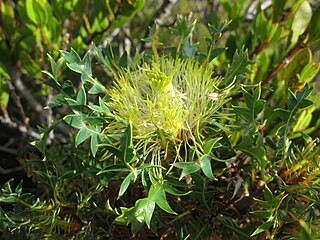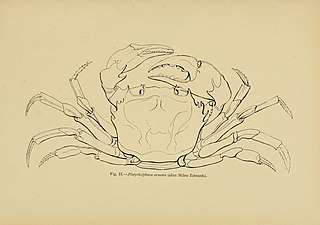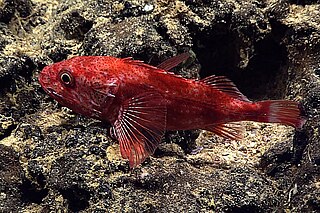A rheophile is an animal that prefers to live in fast-moving water.

The Chilean angelshark is an angelshark of the family Squatinidae found in the subtropical waters of Chile, that grows up to 1.03 metres in length. The holotype is lost. Reproduction is ovoviviparous.

Parascorpaena is a genus of marine ray-finned fish belonging to the family Scorpaenidae, the scorpionfishes. They are native to the Indian Ocean and the western Pacific Ocean.

Banksia armata, commonly known as prickly dryandra, is a species of often sprawling shrub that is endemic to Western Australia. It has deeply serrated leaves with sharply pointed lobes and spikes of about 45 to 70 yellow flowers.

The Platycephalidae are a family of marine fish, most commonly referred to as flatheads. They are relatives of the popular lionfish, belonging to the order Scorpaeniformes.

Banksia armata var. armata is a variety of shrub that is endemic to Western Australia. It differs from the other variety in having a lignotuber, narrower leaves with more side lobes and shorter flowers. It is also usually a shorter plant.

Banksia armata var. ignicida is a variety of shrub that is endemic to Western Australia. It differs from the autonym in not having a lignotuber. It is also usually a taller plant with leaves that are longer with fewer side lobes, and longer flowers.

Platythelphusa is a genus of freshwater crabs endemic to Lake Tanganyika. It has been placed in a number of families, including a monotypic family, Platythelphusidae, as well as Potamidae and its current position in the Potamonautidae, and has also been treated as a subgenus of Potamonautes. It forms a monophyletic group, possibly nested within the genus Potamonautes, which would therefore be paraphyletic. The genus is the only evolutionary radiation of crabs to have occurred in a freshwater lake, and it occurred recently, probably since the Pliocene. This parallels the better known radiation of cichlid fishes in Lake Tanganyika. Only one other species of freshwater crab is found in Lake Tanganyika, Potamonautes platynotus.

The longfin trevally, also known as the longfin kingfish, longfin cavalla or armed trevally, is a species of inshore marine fish in the jack family, Carangidae. The species is common in tropical to subtropical waters of the Indo-Pacific, ranging from South Africa in the west to Japan in the east, typically inhabiting inshore reefs and bays. The species is easily distinguished by its elongate dorsal and anal fin lobes and filamentous dorsal rays, as well as its scaleless breast. Longfin trevally are pelagic predators, taking a variety of small fish, cephalopods and crustaceans, and reach sexual maturity at around 21 cm. The species has a maximum known length of 57 cm and weight of 3.5 kg. The longfin trevally has a very complex taxonomic history which is closely intertwined with another currently valid species, Carangoides ciliarius, which may yet prove to be synonymous. Longfin trevally are of minor importance to fisheries throughout their range and are considered good table fish, and are occasionally taken by anglers.

Dryandra subg. Dryandra is an obsolete clade of plant. It was a series within the former genus Dryandra. The name was first published at sectional rank as Dryandra verae in 1830, before being renamed Eudryandra in 1847, the replaced by the autonym at subgenus rank in 1996. It was ultimately discarded in 2007 when Austin Mast and Kevin Thiele sunk Dryandra into Banksia.

Dryandra ser. Armatae is an obsolete series within the former genus Dryandra. It was first published by George Bentham in 1870, and was given a new circumscription by Alex George in 1996, but was ultimately discarded in 2007 when Austin Mast and Kevin Thiele sunk Dryandra into Banksia.

Asparagopsis armata is a species of marine red algae, in the family Bonnemaisoniaceae. English name(s) include red harpoon weed. They are multicellular eukaryotic organisms that. This species was first described in 1855 by Harvey, an Irish botanist who found the algae on the Western Australian coast. A. armata usually develop on infralittoral rocky bottoms around the seawater surface to around 40m of depth. Marine algae like A. armata are considered “autogenic ecosystem engineers” as they are at the very bottom of the food chain and control resource availability to other organisms in the ecosystem.

Parascorpaena mossambica, the Mozambique scorpionfish, is a species of marine ray-finned fish belonging to the family Scorpaenidae, the scorpionfishes. This species is native to the Indian Ocean and the Pacific Ocean to Micronesia, although the Pacific populations may be a separate species. It occasionally makes its way into the aquarium trade. It grows to a length of 10 centimetres (3.9 in) TL.
Hoplobrotula is a genus of cusk-eels.
Ratabulus is a genus of marine, demersal ray-finned fish belonging to the family Platycephalidae. These fishes are native to the eastern Indian Ocean and the western Pacific Ocean.

Thysanophrys is a genus of marine, demersal ray-finned fish belonging to the family Platycephalidae. These fishes are native to the Indian Ocean and the western Pacific Ocean.

Bairdiella is a genus of fish in the family Sciaenidae.

The T-14Armata, is a next-generation Russian main battle tank prototype based on the Armata Universal Combat Platform.

The channelled rockfish, also known as the deepwater scorpionfish, is a species of marine ray-finned fish, belonging to the subfamily Setarchinae, the deep-sea bristly scorpionfishes, part of the family Scorpaenidae. It has a wide distribution in tropical and subtropical oceans.














